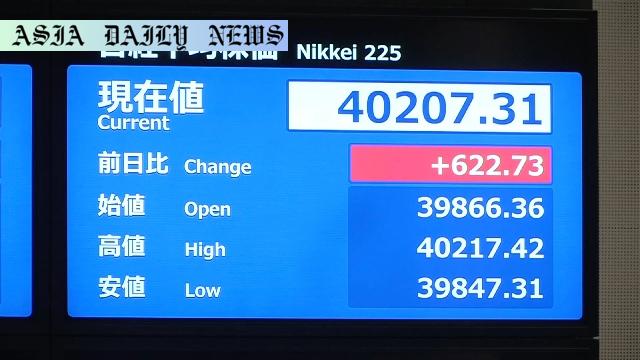Nikkei 225 climbs above 40,000 after Nasdaq’s yearly high boosts global market confidence.
- Nikkei 225 surpassed the 40,000 mark for the first time in five months.
- The tech-heavy Nasdaq set a yearly high, fueling global positivity.
- Market confidence driven by potential US trade tariff extensions.
- Speculation of an early Fed chair nomination influenced rate cut hopes.

Nikkei 225 Breaches 40,000 Mark for the First Time in Five Months
The Nikkei 225, Japan’s benchmark stock index, made a remarkable recovery by crossing the 40,000 level for the first time in five months. This surge was witnessed during Friday morning trading on the Tokyo Stock Exchange, reflecting robust investor optimism and an uptick in global market activity. This milestone comes as a result of factors both domestic and international, with particular attention to the semiconductor-related shares driving Tokyo’s market gains. Market observers noted a more than 600-point rise for the Nikkei 225 early in the trading session, translating to approximately a 1.5% jump. The rally showcases the resilience and potential of Japan’s tech-driven economy in an increasingly competitive global market.
Nasdaq Hits New Heights and Stimulates Global Confidence
Across the Pacific, the Nasdaq Composite in New York achieved its highest level for the year 2025, crossing the psychologically significant 20,000 milestone. This extraordinary surge has garnered attention for its strong implications on the global financial landscape. The Nasdaq’s tech-friendly composition was a major benefactor of investor confidence, spurred by a combination of improved sentiment around trade tariffs and the possibility of a new Federal Reserve chair nomination. Meanwhile, the Dow Jones Industrial Average mirrored the positive momentum, rising nearly 1% in Thursday’s trading as Wall Street welcomed news of potentially prolonged economic incentives.
Factors Driving Market Optimism
Analysts attribute the current wave of optimism to evolving developments in U.S. policy, including possible extensions on trade tariff deadlines that have historically been contentious points in American foreign policy. Moreover, reports suggest that U.S. President Donald Trump may nominate a successor to Federal Reserve Chair Jerome Powell earlier than anticipated, creating speculation about monetary policy adjustments. Such news has further fueled expectations of interest rate cuts, which would provide liquidity and support for economic growth globally. The confluence of these developments has invigorated both retail and institutional investors, leading to significant movements in stock indices around the world.
What’s Next for Global Markets?
As the Nikkei and Nasdaq indices reach new heights, the attention now turns to whether this momentum is sustainable. While tech stocks and semiconductor-related shares have played significant roles in these rallies, market participants are cautiously optimistic about the broader trends in the economy. Moving forward, the trajectory of monetary policy in the United States and stability in trade relations could act as critical factors for sustained growth. For Japan, maintaining its leadership in tech and innovation remains vital as its equity markets look increasingly attractive to foreign investors.
In conclusion, the simultaneous surges in the Nikkei 225 and Nasdaq indices reflect improved global market dynamics and confidence. However, uncertainties around geopolitical issues, central bank policies, and trade regulations highlight the complexity of sustaining such trends in the long run. The developments this week offer a tangible reminder of how interconnected global markets are, reinforcing the importance of strong, inclusive economic policies going forward.



Commentary
A Testament to Global Market Resilience
Markets often serve as barometers for global economic health, and this week’s developments underscore how interconnected the global economy has become. The surge in Japan’s Nikkei 225 and the Nasdaq’s triumphant highs speak volumes about investor confidence and the critical role of policy dynamics in shaping financial landscapes. It’s fascinating to observe how optimism in one region, such as the United States, can ripple across the globe, influencing markets as geographically distant as Tokyo. These milestones highlight not only the vitality of the tech sector but also the significant uncertainties inherent in global trade and monetary policies.
The Tech Sector’s Pivotal Role
There is no denying the immense role that the technology sector plays in shaping global markets today. The performance of semiconductor-related shares in Japan and the tech-heavy Nasdaq reveal the sector’s resilience and potential for driving economic growth. As economies increasingly tilt toward digital transformation, tech companies continue to stand at the forefront of innovation. The confidence seen in these markets reflects both faith in the current performance and hope for the future of technology-driven solutions.
Challenges Ahead and the Need for Strategic Policies
Despite the impressive market rallies, questions remain about sustainability. Trade tariff tensions, speculative monetary policies, and geopolitical uncertainties cast long shadows on these short-term gains. It is essential for policymakers globally to devise strategies that create a balance between encouraging growth and maintaining economic stability. The recent developments are a reminder that, although markets may thrive on optimism, sustained growth requires careful planning, robust policies, and efforts to mitigate risks.
In summary, the surges in the Nikkei 225 and Nasdaq indices epitomize the potential for economic recovery and growth, albeit tempered by underlying vulnerabilities. It will be intriguing to see how these dynamics unfold in the months to come.